5 Tips for Showing your Art to the Public
I’ll be driving south for the San Diego Artwalk in a week. Standing in my art booth, surrounded by 350 other artists and 100,000 people is a pendulum swing of contrast from the typical artists’ solitude in the studio.
Like an athlete pre-visualizing for a game, I’m framing art this week, scribbling notes about booth layout, and thinking about about everything from logistics to conversations.
Presenting art to the public works best with a game plan.
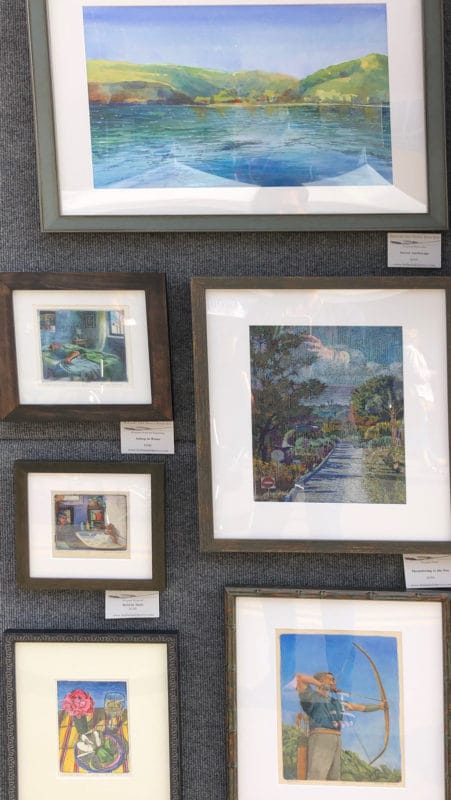
Pre-Motor Planning
Being prepared before presenting your art to the public makes these shows manageable and fun to attend.
I’ve been attending the San Diego Artwalk for over a decade, and I’ve got some tips to help you prepare for showing and talking about your art. Grab a notepad and let’s dig in.
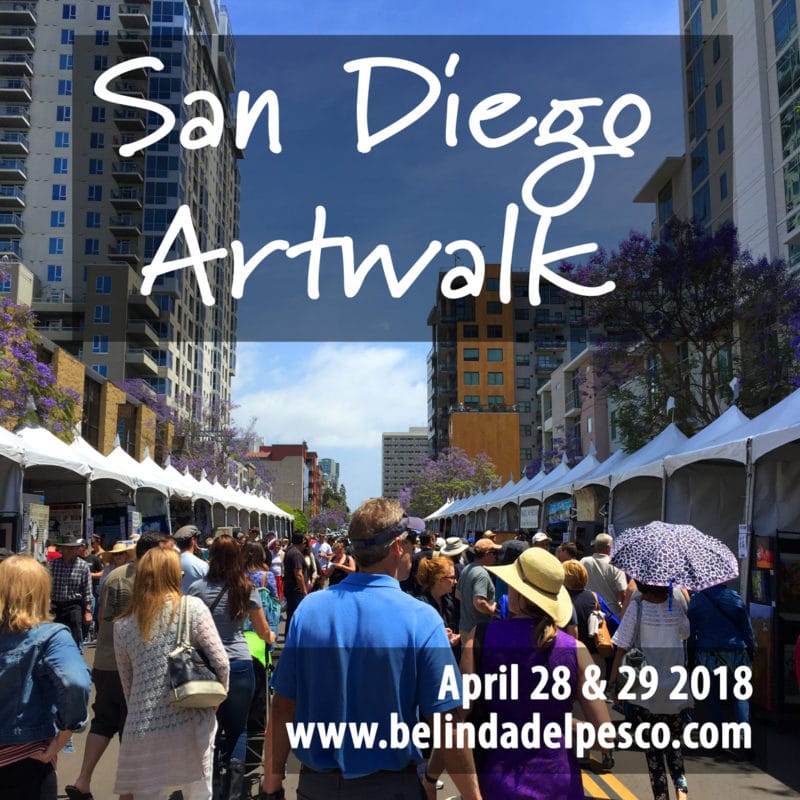
Tip #1: Questions People Ask at Art Festivals
Think about appropriate answers to the questions people ask at art events, so you’re not fumbling for an answer.
You don’t want to be the one doing all the talking.
Grab a beverage, and sit with a notepad to write (writing vs typing helps you retain information) brief, friendly answers to the questions exhibit attendees ask.
Often, they are just being conversational and friendly, so answer the question with an economy of words, and then ask something back.
Volley the chit-chat.
- What’s the difference between oil paints and watercolors?
- How did you make this?
- Is there a story behind this painting?
- Do you paint from photos that you take?
- How long did it take you to paint this?
- Where do you get your frames?
- Is this landscape from (insert place)?
- Can I get this with a different frame?
- What’s the difference between printmaking and a print I’d buy at Target?
- Do you have a website where I can look at more, or buy something online?
- NOTE: Let me know in the comments in you need some help with simple and fun answers to these questions.
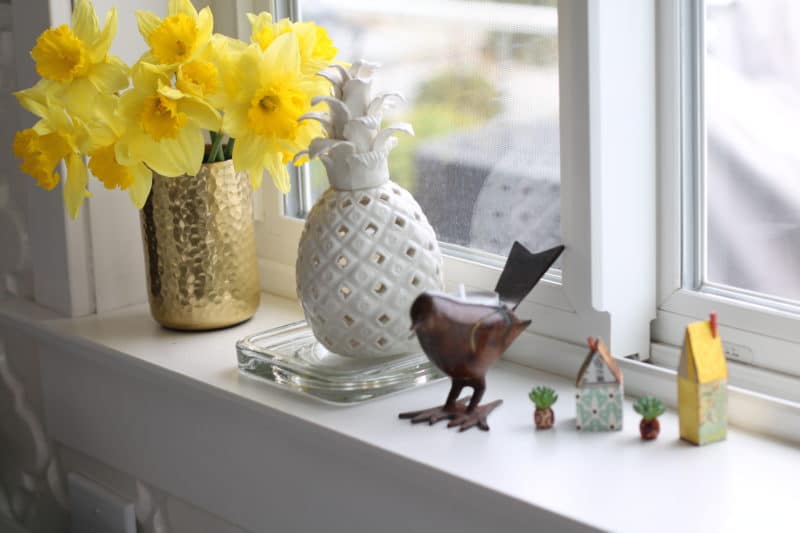
Tip # 2: Swap Art Supplies for Presentation Supplies
Just like so many other things that make you squirm (read: grow), jumping into (and preparing for) an exhibit of your work is a good idea.
Discussing art with a family member, or writing about it on a blog isn’t the same as standing with your art among hundreds of strangers.
Add to that the pressure of a venue where the whole premise is to sell your art.
So, let’s shiny-up your presentation skills.
- Have business cards or postcards with your contact information handy, and offer them (casually) to folks you’ve chatted with.
- Bring a blank notebook with a couple of pens, and ask the people you’ve had conversations with if they’d like to be added to your mailing list, so you can send a postcard or an email about future shows, or studio sales (make sure you can read their email or postal address before they leave your booth).
- Wear a name badge; even though your art might have a label next to it, or a sign close by, art festivals and exhibits are an overwhelm of visual information to attendees. They won’t all know you’re the artist connected to the work next to you; you could be a gallerist or a sales person. Wear a name tag, and when they ask “Is this your art?”, smile, and answer, “Yes it is. My name is _______. What’s yours?” Shake hands and welcome them.
- Keep an inventory sheet close by. List each piece you’re exhibiting, with the title, media, price and outside dimensions. If a patron wonders if your latest painting will fit over their dresser, you can jot down dimensions on the back of a business card with the title and media of the art. Offer to collect their contact info to follow up with them later.
- Snap photos of your booth set up, the environment around the art festival and noteworthy characteristics of the space where you’re exhibiting. If you return to the show next year, you can review your set up, and if you need booth photos to apply to other shows, you’ll have them. You can also write a blog or social media post about your experiences which might be interesting to folks too far away to attend, and informative to other artists considering that show.
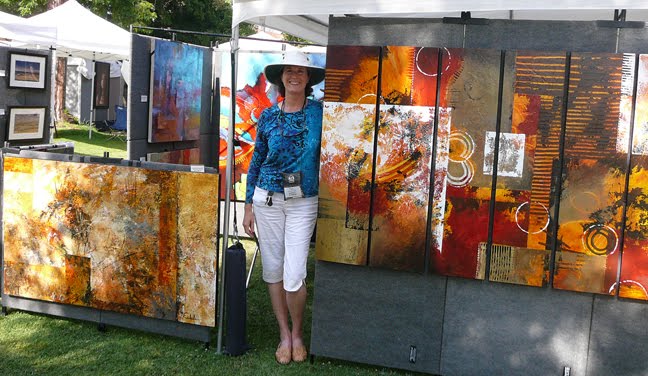
Tip # 3: The Bad Rap of Salesmanship
Keep in mind that you’re selling handmade, soul-inspired, time-invested original art – not reconditioned tires.
Artists often sprout a dismissive expression with a curled lip on the subject of selling. They skin fine art sales with the caricature of a salesman, associated with pressure to buy and slick deals made with a wink and an elbow-nudge.
Don’t Judge
I invite you to close the curtain on those salesman cartoons, and consider that selling your art is more of a service.
Patrons – people who love and collect art – are searching for something to line the walls of their nest.
The attendees combing an art exhibit could be looking for a deeply personal piece that moves them, or they could be trying to match a new couch. Don’t judge.
You’ll meet folks looking for the latest color trends, or a gift for friends getting married, or a landscape with a path to remind them of childhood walks taken with a recently lost grandparent.
Whether they’re trying to match wallpaper, or looking for a commissioned portrait, help them distill what they find appealing by asking questions about what they already have, what style they’re drawn to, and which subjects catch their eyes, etc.
Being interested is easier (and kinder) than being interesting.
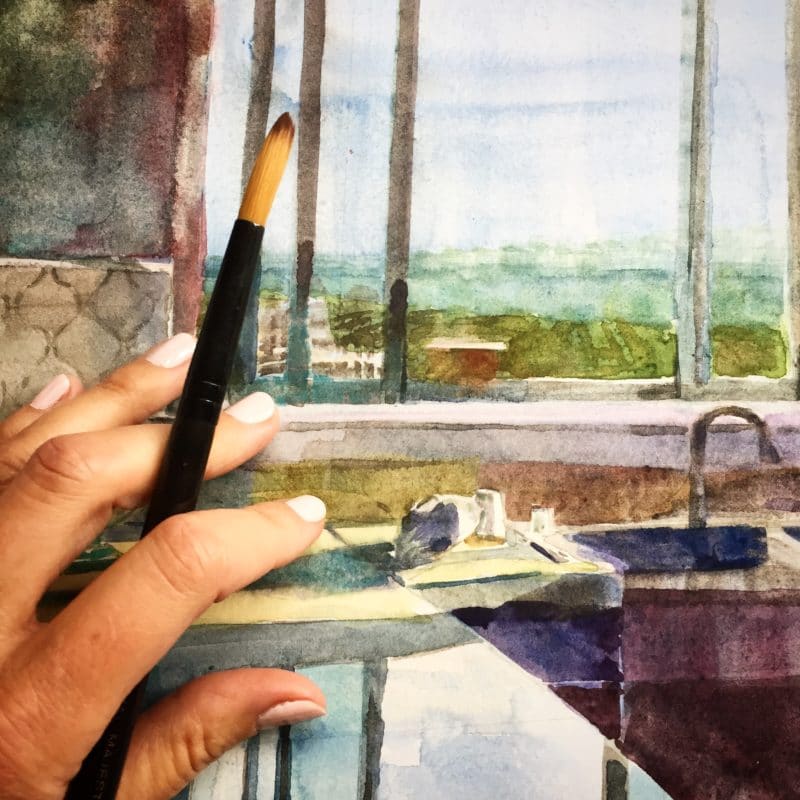
Tip #4: Like Water off a Duck – It’s Not Personal
Your job, as an artist standing next to the work you’re offering for sale, is to assist buyers with their search for something to add to their collection.
Making the art is all about you, but selling your work shifts the focus away from you, to the patron.
You’re in the service of matchmaking; getting your art in front of a collector searching for your style.
If your art doesn’t speak to someone surveying your work, and it’s not their jam – there’s no penalty box. It’s simply not a match.
That’s not a reflection of your work; it’s a reflection of their tastes, and you should never personalize that.
Yes, you made the art, and there’s a lot of you in the work, but if a collector doesn’t love it, the only conclusion worth pondering is where to find the collectors who are looking for your style, subject, palette and media.
I love salad, and my husband thinks of it as rabbit food. That’s not the salad’s fault as much as it’s a reflection of our varied tastes. Don’t take it personally if someone doesn’t fall in love with your art.
Keep searching & showing till you get the art in front of people who do love it. They’re looking for you.
Tip # 5: Follow Up
After the event is over, and you’ve loaded what remains of your artwork back into your studio, take some notes & follow up.
- Add the people you met to your mailing list, and in the notes on each contact, remark where & when you met them, and which pieces they were drawn to. Send them a short, chipper note to let them know you enjoyed meeting them, and you’ve added their contact info to your mailing list. Thank them for stopping by, and let them know you’ll be in touch the next time you’re showing work in their region.
- Update the art on your web site and/or blog to reflect which pieces sold, and adjust your database of inventory to mark those pieces as Out of Stock.
- Take some notes on the show; was there any equipment you wish you had?
- Did the crowd respond better to smaller art, figurative vs still life, or a particular style in your series?
- What was the high and low of your price point sales?
- Do you have ideas for adjustments to your promotional campaign, layout or booth space for next year?
- Send a friendly email to anyone you left loose ends with; if someone needed to measure before committing to a piece, ask them if the art will fit in their space, and include an image of the art in the email.
- Take a long, hot bubble bath with candles, and breathe deep while you pat yourself on the back for a job well done.
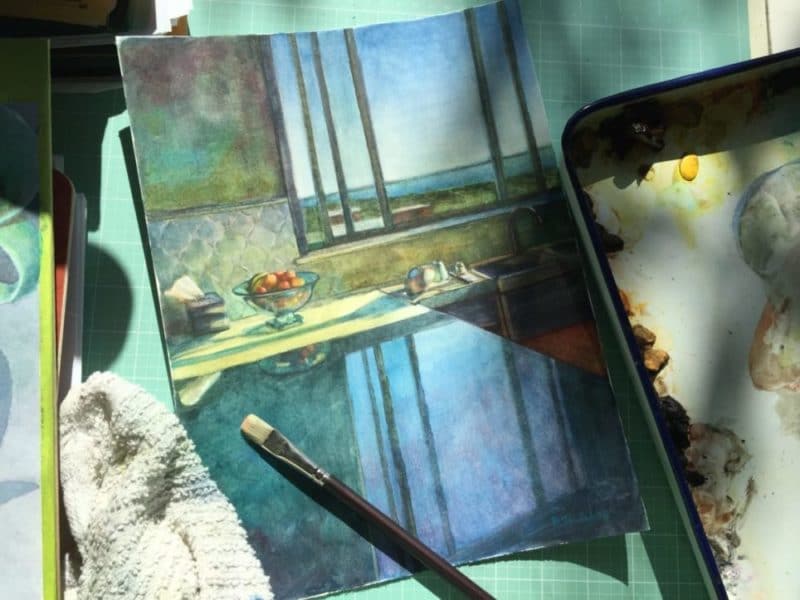
Bonus Tip: Take Care of Yourself
- Standing in front of your art while strangers survey work birthed from your soul can feel like a talent contest. It’s a lot of work, and hard on the nerves. Make sure you’re prepared in advance so the days leading up to the exhibit aren’t disorganized and harried. You’ll need that adrenaline for the exhibit.
- Get a good night’s sleep, drink lots of water, and eat light, healthy meals leading up the the exhibit. You’ll want to be on your best game, and the stress is hard enough to quell – so we don’t need added layers of dehydration, indigestion and fatigue.
- Wear comfortable shoes. Bring a chair when presenting your art, but when people come into your booth, stand to talk with them. Move around the booth with them, and stay engaged in the conversation. Give them space when they need it, but stay upright and ready for their questions. If your dainty heels leave your dogs (feet) barking, you’ll be less present, and it’ll be no fun.
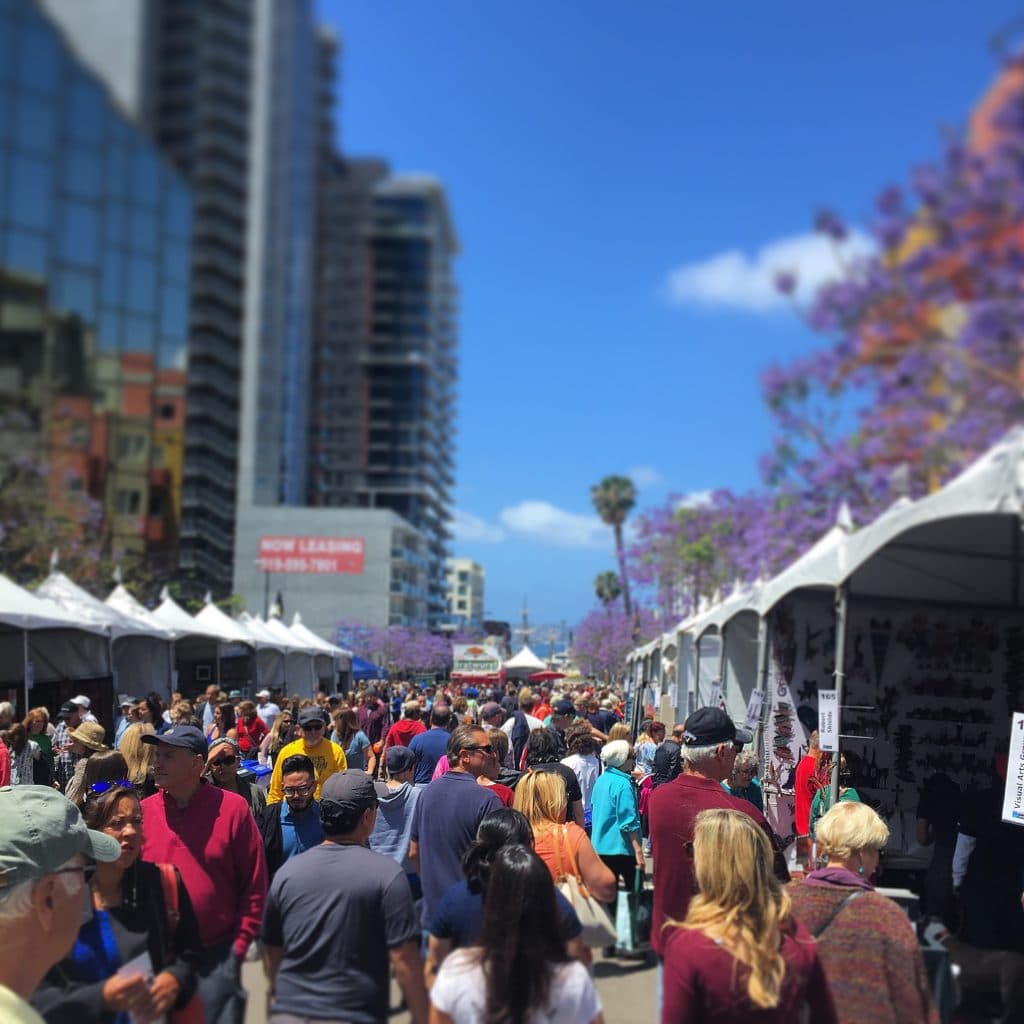
Don’t Reinvent the Wheel
Talking about your art is much easier if you have some tips as a leading-off point, and you’ve thought about the mechanics of it beforehand. Role play art sale conversations with a family member so you can shake your jitters off.
Take a friend to an art festival, and pay attention to how each artist you visit interacts with you. What did you like, and what was less engaging? Take some notes over kettle corn and an iced coffee afterwards.
Folks have been selling stuff for thousands of years, so you don’t have to figure it out solo. Do a little research, put a loose plan together, and give it a whirl. Worst case scenario: you’re a drooling, quaking mess at the show with feet-blisters and a sunburn. Nahhh, that wouldn’t happen! Just kidding!
Really, the worst case is that you don’t sell, but remember to shake that off. There’s no time to be discouraged, because you need to research and find the folks looking for your art. At each subsequent show, you’ll be honing your skills at presenting your art till you’re an art exhibit superhero. ??
If you have a friend who’s thinking about showing work, forward this to them. Tell them to Go for it! There’s no looking back, because you’re not going that way.
Thanks for stopping by today and I’ll see you in the next post – or at San Diego!
Belinda
P.S. You can subscribe to get each post as an email as soon as they’re published (it’s free) right here.
P.P.S. If you’re reading this, and you have exceptional social skills, you’re naturally funny, swaggeringly good looking, and at ease talking & sparkling in front of a crowd of strangers, please leave conversational-tips in the comments. We’d all really appreciate it. 🙂
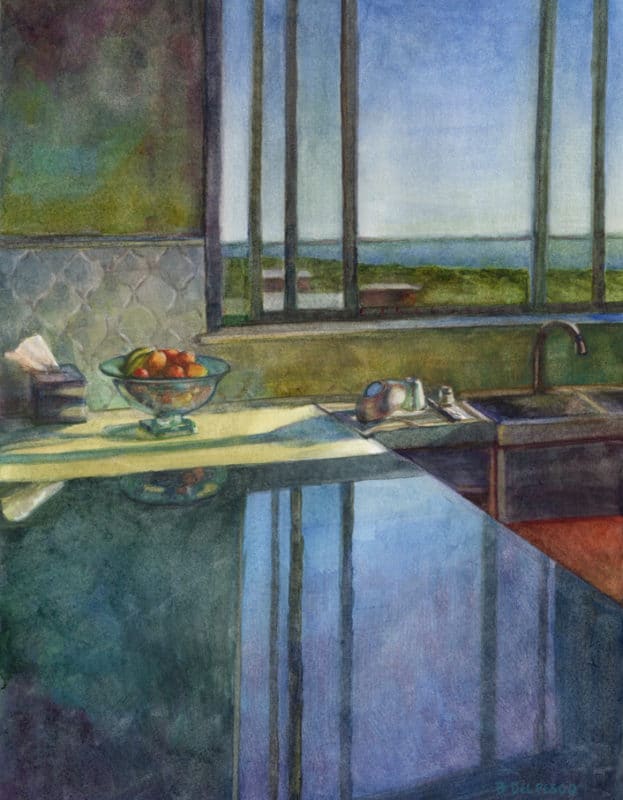
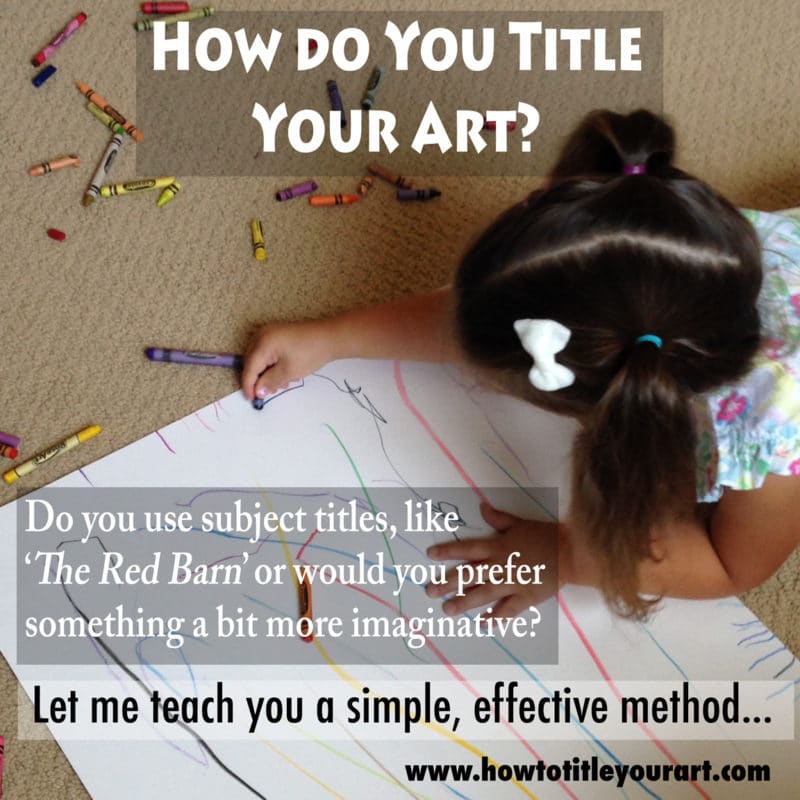
Art Quote
A great piece of art is composed not just of what is in the final piece, but equally important, what is not. It is the discipline to discard what does not fit – to cut out what might have already cost days or even years of effort – that distinguishes the truly exceptional artist and marks the ideal piece of work, be it a symphony, a novel, a painting, a company or, most important of all, a life.
Jim Collins

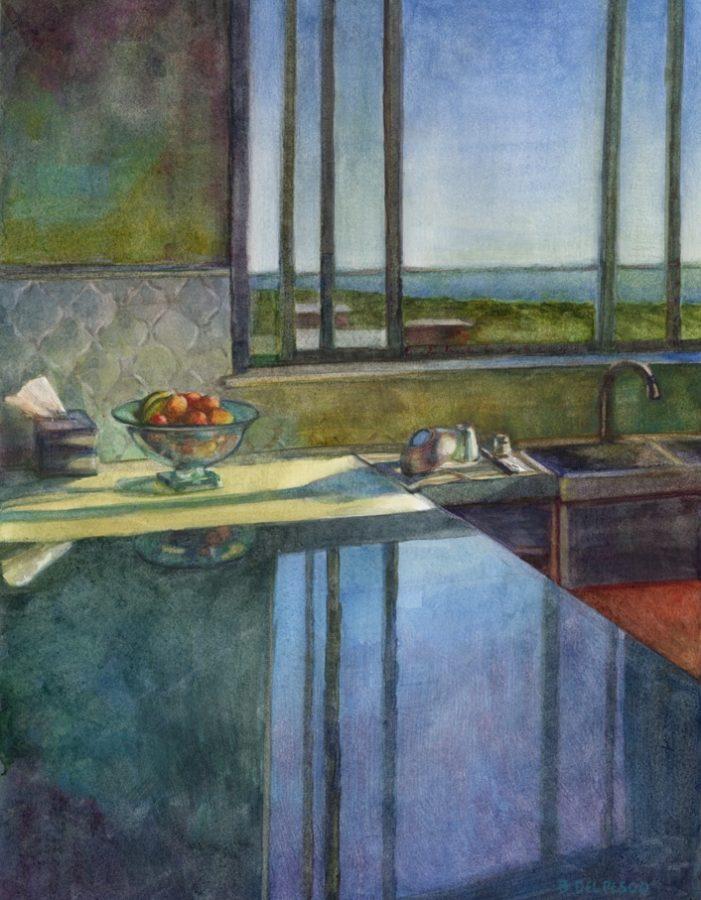
Hi Belinda: This is EXCELLENT! I am wondering if I would have your permission to post it o=in our art groups’s newsletter, with full accreditation to you of course?
Just love you and your beautiful and haunting work
Sharon
Hi Sharon, Thanks so much for your kind comment, and all of your encouragement in these posts. You can absolutely share these tips. I hope they are helpful to whoever reads them!
“Being interested is easier (and kinder) than being interesting.” That’s nice and wise.
Thanks, Johannes – I’m aiming for wisdom over wit, since I have neither. 🙂
What do you say to the person who is loving your work, and one piece in particular, let’s say it’s $500, and they say, “I really love this piece; will you take $400?” How do you respond to that?
Hi Jack, That’s an excellent question, and one to add to the pre-motor planning at a show. Everyone is different on this front. To me, the first two considerations are to have a clear idea of how much the art cost you to make in time and materials, and then to be careful not undercut your galleries. Considering those two parameters, I negotiate all the time. Other considerations: How long has the art been in your inventory? Are they buying more than one? Are they a repeat buyer? Did you just have an excellent conversation with them, which established a kinship, and would make you happy to be a part of their collection? You can say no as often as you like, but it’s helpful to have your own set of Yes-Initiators, if you know what I mean?
I have scant experience of Arts Fairs but one thing I have found is useful is to have a few art materials to show. For example a collagraph plate, tube of ink and a brayer. I have taken my portable press too.
My banner also shows these things.
Hi Carol, That’s an excellent tip! Folks who aren’t artists have no idea how this stuff is made, so having tools, printmaking plates and a booklet of process photos is super helpful. PLUS, it inspires people to give your method a try, so you are actively and enthusiastically sprouting new artists, and that’s the best!
Thank you Belinda! I just held an open studio event and your tips are spot on! I’m practicing for something bigger one day. My tip is to ask someone showing interest in a piece what it says to them or why they feel attracted to it. Or, I will offer a line or two about why I painted that subject. People love to have or hear the “story” of a painting.
Hi Laura, Great tip! It’s so true; when art speaks to people, you can see it in their face. Like a camera of memories begins to play in their mind as they look at a particular piece of art. If they’re willing to share, or they’re able to relay what they see, it’s a wonderful, connected moment. Thank you!
I love your blogs, Belinda, and can’t wait to read each new one that comes in. The way you paint reflected surfaces is dazzling! Maybe someday I can paint them too.
Thanks for the kind words, my friend! You can absolutely paint reflective surfaces. Keep getting acquainted with your watercolors, and test various papers so you know your tools. This is all brand new to you. Play first, master later. XO
Passing this on to all the artists I know . Just great Belinda. Love your art work and your blog. Enjoy SanDiego
Hi Cindi – Thanks for that share, and for the encouragement! I hope all is well in your world, and your art supplies are groovin’!
Belinda, thank you for this! You are so upbeat and encouraging. Wonderful advice!
Hi Candy, Thanks for the feedback! I’m so glad the advice was helpful to you!
Great tips. No 4 is such great advice.
I am guessing the art fair is healthier out west?
Hi Jim, Art Fairs out here appear to be struggling from lack of attendance/artist participation. Several in Southern California that I’ve shown in regularly closed down just this year. Others (like the San Diego Artwalk) are flourishing, so it’s anyone’s guess where the breakdown resides. Thanks for the feedback – I’m glad you found the tips useful. 🙂